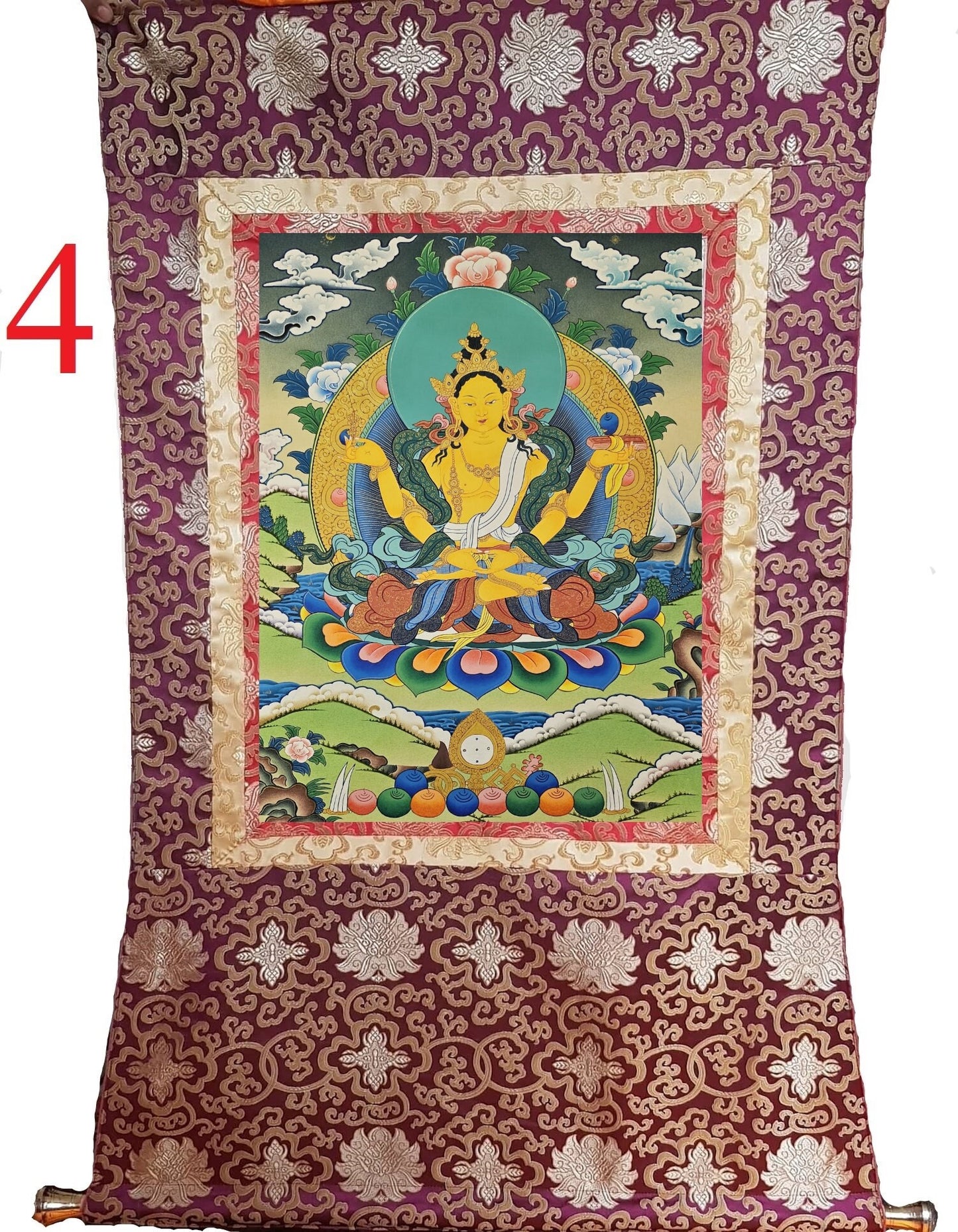1
/
of
6
My Store
22. Prajnaparamita Thangka (Thanka). Free Brocade / Free Shipping.
22. Prajnaparamita Thangka (Thanka). Free Brocade / Free Shipping.
Regular price
$365.00 USD
Regular price
Sale price
$365.00 USD
Quantity
Couldn't load pickup availability
Prajnaparamita (Perfection of Wisdom)
Prajnaparamita, (Sanskrit: “Perfection of Wisdom”) body of sutras and their commentaries that represents the oldest of the major forms of Mahayana Buddhism, one that radically extended the basic concept of ontological voidness (shunyata). The name denotes the female personification of the literature or of wisdom, sometimes called the Mother of All Buddhas. In the Prajnaparamita texts, prajna (wisdom), an aspect of the original Eightfold Path, has become the supreme paramita (perfection) and the primary avenue to nirvana. The content of this wisdom is the realization of the illusory nature of all phenomena—not only of this world, as in earlier Buddhism, but of transcendental realms as well. The main creative period of Prajnaparamita thought extended from perhaps 100 BCE to 150 CE. The best-known work from this period is the Astasahasrika Prajnaparamita (Eight Thousand-Verse Prajnaparamita). The first Chinese translation appeared in 179 CE. Later some 18 “portable editions” were forthcoming, the best-known of which is the Diamond Sutra. Still later, schematic and scholastic commentaries were produced in the Madhyamika (“Middle Way”) monasteries of eastern India, thus introducing into the Prajnaparamita movement the same confining rationalism against which it had reacted in the first place. The radically anti-ontological stance had been intended to free the spirit in its quest for experiential enlightenment. The way of negation, however, is not the sole content of these texts. They incorporate, as aids to meditation, the numerical lists (matrika) also found in Abhidharma (scholastic) literature. They also supplement their philosophical austerity with the personally appealing figures of mythology. The Chinese traveler Faxian described images of the personified Prajnaparamita in India as early as 400 CE, but all known existent images date from 800 or later. She is usually represented yellow or white in colour, with one head and two arms (sometimes more), the hands in the teaching gesture (dharmachakra-mudra) or holding a lotus and the sacred book. Also frequently associated with her are a rosary, sword (to cleave away ignorance), thunderbolt (vajra, symbolizing the emptiness of the void), or begging bowl (renunciation of material goods being a prerequisite to the obtaining of wisdom). Images of the deity are found throughout Southeast Asia and in Nepal and Tibet. In Vajrayana (Tantric) Buddhism, she is described as the female consort of the Adi-Buddha (first Buddha).
Origin of the Prajnaparamita Sutras
Mahayana Buddhist legend says that the Prajnaparamita Sutras were dictated by the historical Buddha to various disciples. But because the world was not ready for them, they were hidden until Nagarjuna (ca. 2nd century) discovered them in an underwater cave guarded by nagas. The "discovery" of the Prajnaparamita Sutras is considered the second of the Three Turnings of the Dharama Wheel. However, scholars believe the oldest of the Prajnaparamita Sutras were written about 100 BCE, and some may date to as late as the 5th century CE. For the most part, the oldest surviving versions of these texts are Chinese translations that date from the early first millennium CE. It is often taught within Buddhism that the longer Prajnaparamita sutras are the older ones, and the much briefer Diamond and Heart sutras were distilled from the longer texts. For some time historical scholars partly supported a "distillation" view, although recently this view has been challenged.
The Perfection of Wisdom
It has been thought the oldest of the wisdom sutras is the Astasahasrika Prajnaparamita Sutra, also called The Perfection of Wisdom in 8,000 Lines. A partial manuscript of the Astasahasrika was discovered that was radiocarbon dated to 75 CE, which speaks to its antiquity. And it was thought the Heart and Diamond sutras were composed between 300 and 500 CE, although more recent scholarship places the composition of the Heart and Diamond in the 2nd century CE. These dates are mostly based on the dates of translations and when citations of these sutras appeared in Buddhist scholarship. However, there is another school of thought that the Diamond Sutra is older than the Astasahasrika Prajnaparamita Sutra. This is based on an analysis of contents of the two sutras. The Diamond seems to reflect an oral recitation tradition and describes the disciple Subhuti receiving teachings from the Buddha. Subhuti is the teacher in the Astasahasrika, however, and the text reflects a written, more literary tradition. Plus, some doctrines appear to be more developed in the Astasahasrika.
Size:
Size without Brocade: 15 inches by 20 inches
Shipping:
We ship within 2 business day.
DHL Shipping: 5 to 8 business days with tracking number.
Insurance against loss.
We do wholesale too.
Our one and only priority in this business is to provide "Hassle free Customer Satisfaction". We have "Quality Products" with "Cheapest Price" in the market.
Please contact us to resolve any issues. Contact us via email before leaving any negative or neutral comments. We promise you that we will resolve any issues.
Please confirm the return address with us before returning the product.
Share











